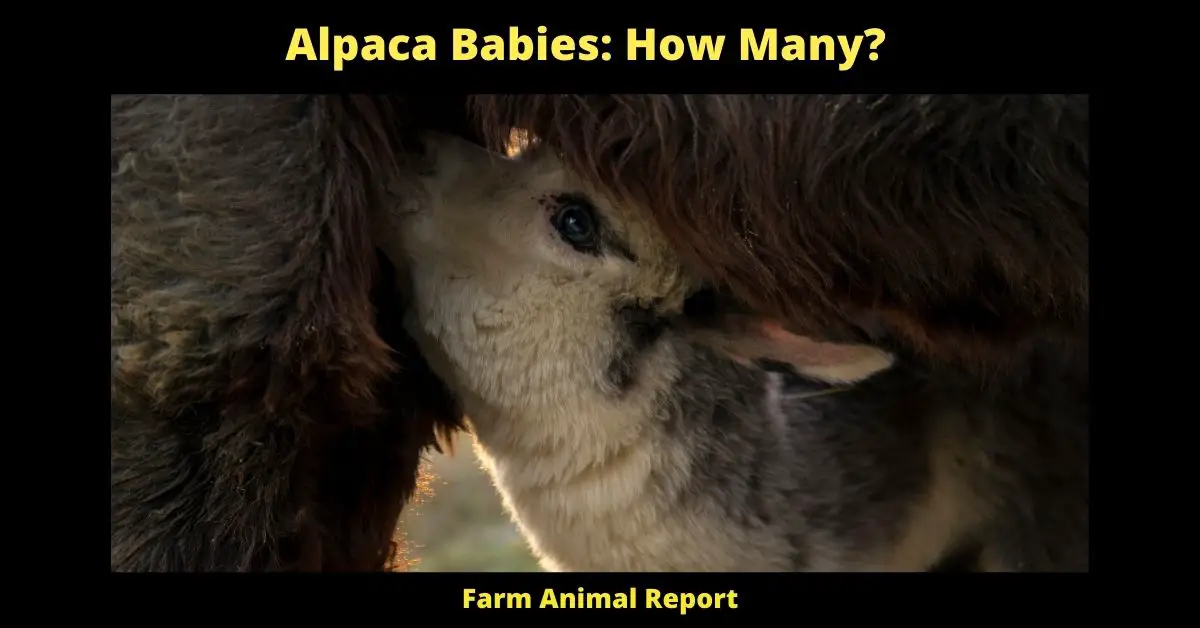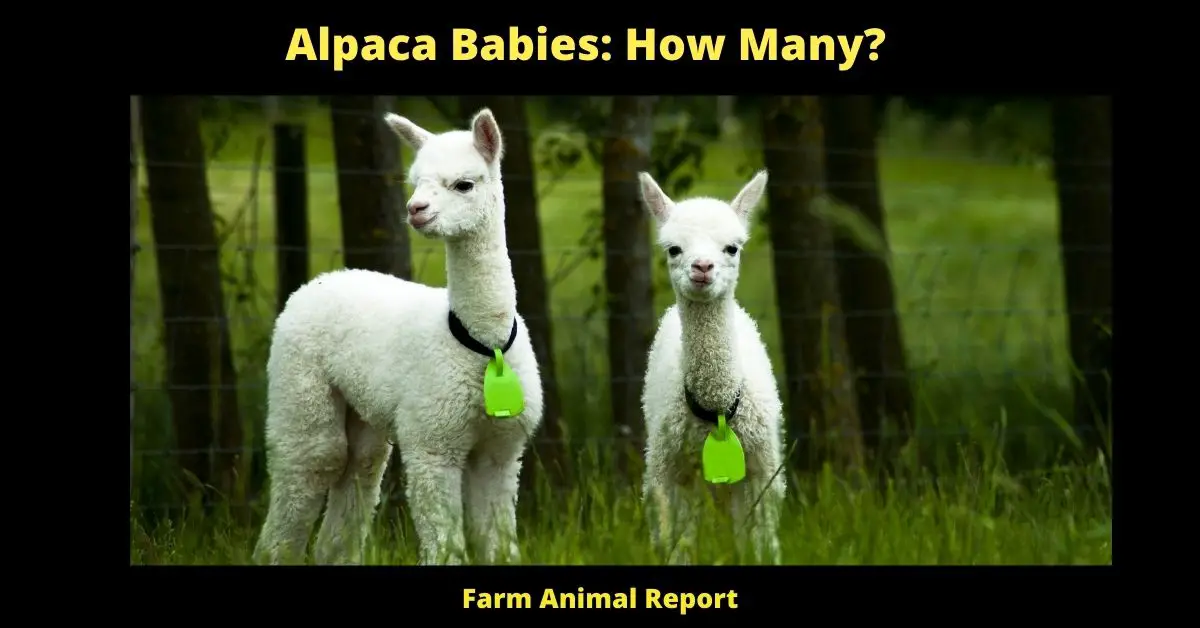As a General rule Alpacas breed once a year, and as livestock, they are often induced to breed at any time. The female alpaca has a gestation period of 242 to 345 days and gives birth to just one offspring. Usually born in spring is best.
Alpaca Babies: How Many?
The people who have alpacas are always wondering just how many babies they can expect. The answer is that there’s no way to tell, but the average is usually one every two years or so. Alpacas are herd animals, so it’s rare for them to be alone and without a companion their entire lifetime.
Alpacas are Herd Animals and Live in Groups of up to 20 Individuals
The baby is born with its eyes open, an unusual trait among mammals at birth. It has developed muscle control over most of its body while it is still in the womb, but cannot control its trachea and has no sucking reflex.
Alpaca Babies – They are South American camelids that have been domesticated since 5000 BC for their fiber, meat, and the male’s ability to be used as a pack animal or sires of alpacas.
Within a few minutes of birth, it crawls up its mother’s abdomen to her chest and finds one of her four teats where it attaches itself for around seven months. The baby alpaca gives extremely rich milk that contains more fat and protein than cow’s milk.

Alpaca Babies – The baby alpaca will start to take its mother’s food from the moment it is born and has a very sharp sense of taste that tells it what plants are good for eating. In just six months its teeth have grown enough so they won’t fall out and be replaced with new ones like many other species.
The alpaca is naturally curious, loves company, and seems to enjoy being close to other animals. It will often follow the herd’s leader wherever they go, but it can also be tempted with food or a treat like fruit or sugarcane. Alpacas are very intelligent creatures who learn quickly when shown what to do in certain situations.
Jump to Newborn Alpacas-Baby Alpacas-Extensive Guide
An alpaca Usually can have One, more Uncommon Two,
babies after about 11 months of gestation. Usually, females give birth to only one baby at a time. Twins are very rare, and it is even more unusual for them to survive infancy.
Alpaca mothers give birth standing up and they do not lie down until after the babies have tried to stand on their own four legs or attempted to suckle from their mother’s udder.
After giving birth, the mother will lick off her babies and consume the placenta. This helps to keep down odor as well as remove all traces of blood from their coats so they do not attract predators.
To prevent complications during birth, alpacas remain standing throughout labor and delivery since lying on one’s side can obstruct breathing or restrict circulation in some alpacas.
Baby Alpacas are called Crias.
Alpacas are born with a single baby, cria. Cria comes from the Spanish word for “offspring”. A pregnant alpaca can have one to two babies at once. In rare cases, an alpaca has been known to give birth to three or four babies! The gestation period (length of pregnancy) for an alpaca is about 11 and a half months. This means that typically, you can expect your alpacas to give birth around April or May of each year.
There are two types of alpaca births, called twins and yearling. ~~~ Most crias live through their first six months because they tend to be born early or late in the season making them vulnerable to weather extremes. Alpacas do not have teeth but instead eat grasses by chewing them up into a pulp which they then swallow.
Baby alpacas are born with a thick coat, which they shed very quickly.
Cria is generally brown with white markings at birth and becomes darker as they age to their adult coloration of black or dark brown by the time that they are one year old. However, alpacas come in many different colors including grays, fawns, reds, and creams.
The Gestation Period for an Alpaca is 11 months
Alpacas have induced breeders which means that they will only breed during a certain time of year.
When it comes to Baby Alpacas, there are two types of births that you can have:
A natural birth means that the mother will give birth on her own.
A cesarean section also called a C-section or caesarian is when the baby
is delivered via a surgical incision in the abdomen of the dam (mother). This procedure can be done for various reasons including dystocia (difficulties during delivery), fetal distress, or other health concerns.
C-sections are also used to maximize the number of offspring a female alpaca can have in one year. In many cases, twins will be delivered by C-section and then each baby is raised separately from its mother for about three months before being weaned. This allows both babies to get more nutrients while the mother is lactating and also allows for a better bond to form between the dam (mother) and her offspring.
C-sections are very common in alpacas, but even if you plan ahead your vet may not be able to do one because of weather or other factors that can potentially affect both mom and babies during this type of surgery.
You’ll know when the Mother has Given Birth
She will because her water breaks
She will be restless and try to lie down often, but maybe not because her back end seems very tight. The change in behavior is important so that the farmer can prepare properly. If there isn’t enough time or room for a new baby to be born, the mother could become sick.
If you notice that she is going into labor at night and isn’t due for a couple of weeks, it’s best for her so that she doesn’t have to give birth outside in bad weather or other conditions. The farmer should never try pulling out the baby because if he does this incorrectly, then the mother could become.
If you or someone that you know is going to have alpaca babies, it’s best to consult with a veterinarian so they can give them proper vaccinations. This way, if there are any problems while giving birth, the farmer will be prepared and ready to take care of them properly. Alpacas are very gentle animals so they are not dangerous to humans. Most of the time, if something goes wrong it’s because the farmer has done something incorrectly or tried to do too much for an animal that is naturally independent and doesn’t need help often.
Jump to Bottle-Feeding Alpaca Cria
Alpacas usually Give Birth
- In about one hour once the delivery starts. The mother can often tell when the birth is about to happen because she will be restless and sometimes anxious. Alpacas usually give birth standing up, or at least try too! Most of them do not like lying down for long periods after giving birth.
- Alpaca mothers are protective but they do not normally need some help from us
- After that, when she is able, she will clean her baby very well by licking off all of the afterbirth fluids.
- The cria can stand and walk a few minutes after birth.
- After the cria is born, it will rest for about two hours and then try to join its mother standing up. The baby alpaca looks almost like an adult with just a bit of fuzz on top of his head! In general, this young one can nurse from all three nipples but will mostly nurse from the one closest to its side.
- When it comes time for weaning, which is usually between five and six months old
Final Thoughts
In summary, most alpacas will give birth on their own without any assistance from humans. However, if the farmer notices that something is wrong with the mom or baby during labor and delivery they should call a veterinarian immediately so they can take care of it properly. C-sections are common in alpaca births because it allows both babies to get more nutrients while the mother is lactating and also allow for a better bond to form between the dam (mother) and her offspring.


